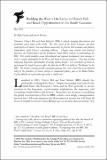Files in this item
Building the West's on-ramp to China's Belt and Road : opportunities in the South Caucasus
Item metadata
| dc.contributor.author | Fawn, Rick | |
| dc.contributor.author | Bruder, Jason | |
| dc.date.accessioned | 2022-09-23T14:30:02Z | |
| dc.date.available | 2022-09-23T14:30:02Z | |
| dc.date.issued | 2022-07-01 | |
| dc.identifier | 278368114 | |
| dc.identifier | f51325d4-d6bc-465b-a0ea-498e3ec1f0eb | |
| dc.identifier | 85133495945 | |
| dc.identifier.citation | Fawn , R & Bruder , J 2022 , ' Building the West's on-ramp to China's Belt and Road : opportunities in the South Caucasus ' , Orbis , vol. 66 , no. 3 , pp. 350-372 . https://doi.org/10.1016/j.orbis.2022.05.006 | en |
| dc.identifier.issn | 0030-4387 | |
| dc.identifier.other | ORCID: /0000-0003-1903-8773/work/115631193 | |
| dc.identifier.uri | https://hdl.handle.net/10023/26065 | |
| dc.description.abstract | China’s Belt and Road Initiative (BRI) is already changing infrastructure and production across much of the world. The three states of the South Caucasus and their counterparts in Central Asia need diverse connectivity to preserve their economic and political independence amid China’s expanding influence. Despite some rhetoric and practical measures, the United States and the European Union (EU) continue to underestimate the BRI. This article identifies recent international and regional developments that converge to create a unique opportunity for the West and South Caucasus partners. They may develop integrated, long-terms infrastructure of lasting mutual benefit. The convergence of events in and around the South Caucasus offers the place for the West to build an “On-Ramp” to the BRI. The South Caucasus provide a potential gateway into Asia’s heart that is not dictated solely by the priorities of Chinese foreign or commercial policies, just as the Baku-Tbilisi-Ceyhan pipeline of a generation ago served a similar role. | |
| dc.format.extent | 333597 | |
| dc.language.iso | eng | |
| dc.relation.ispartof | Orbis | en |
| dc.subject | JZ International relations | en |
| dc.subject | T-NDAS | en |
| dc.subject | NCAD | en |
| dc.subject.lcc | JZ | en |
| dc.title | Building the West's on-ramp to China's Belt and Road : opportunities in the South Caucasus | en |
| dc.type | Journal article | en |
| dc.contributor.institution | University of St Andrews. School of International Relations | en |
| dc.identifier.doi | https://doi.org/10.1016/j.orbis.2022.05.006 | |
| dc.description.status | Peer reviewed | en |
This item appears in the following Collection(s)
Items in the St Andrews Research Repository are protected by copyright, with all rights reserved, unless otherwise indicated.

